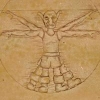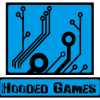Predictable movement doesn't mean it's not fun and/or challenging. All the moves in chess are predictable and yet it's the ultimate strategy game.
The fun about chess is actually predicting your opponent's moves from a preset list of moves. It is a viable and fun gameplay mechanic.
However, I found that (through playing Battle Fleet 2) I also enjoyed attempting to predict movement patterns of my own ships based on general guideline.This is also present in games like X-Wing Miniatures where you are not allowed to measure the outcome until resolution.
This approach reinforces the player's ability to estimate outcomes based on previous experiences and in turn insures that the winners, on average, are the most skilled players.
For example, X-Wing is often taxed to be a random dice game, but 3 years in a row, the same guy won the world finals. That goes to say how much positioning and gauging possible outcomes is relevant. In his 2014 match, the winner actually was one millimeter away from crashing into an asteroid. His opponent dismissed this possibility because he did not gauge the movement appropriately and discarded that outcome, but the winner went on to take a dominating position and striking a decisive blow against his opponent.
I feel that guiding the player too much makes it easier to play, but less about player skill (to a degree). It is perfectly valid, but it doesn't mean it can't be made any better.
Chess is also the ultimate strategy game because it has endured, but its finite nature means that since 2005-2006, it is assumed that a sufficiently sophisticated AI can consistently defeat grandmasters. As much as I love chess, there is indeed a design limitation that makes it finite in nature.
The alternative is also finite, but multiplies the complexity by quite a margin, especially since, in my design, all units move "at once" (simultaneously executed).
This means that unlike having each side alternately move one unit (and possibly moving the same unit over and over), all units get to move, introducing a lot of unknowns.
It is possible that increasing the risk by making the movement of your own units less predictable would be too much, but the notion carries a lot of weight regardless.
As you point out however, it does not guarantee more fun, but it certainly makes it more challenging.
I'm actually working on a little prototype that uses something similar to the last movement type, so it's a little disappointing to hear that I wasn't as original as I thought, but absolutely fantastic to hear that the scheme works and was fun. I came up with it while trying to make a slightly less restrictive movement control than the scheme presented in SteamBirds, so that's another game you might look at for an example.
Great minds think alike :)
Definitely going to have a look at SteamBirds now (Did not turn up during my searches).
That's not necessarily a bad thing unless you really want difficult-to-predict movement as a feature. Players still have the difficulty of ensuring their target position and heading is possible within the movement arc, which can be increasingly difficult when trying to plan multiple moves ahead and deal with the unpredictable movement of another player.
I think a lot of tactics players will appreciate having predictable control over their movement with the challenge coming from responding correctly to the environment and opponent, where they might feel a bit ripped off if they have a tactically sound plan but lose the battle due to uncertainty in the movement controls.
Actually, I was thinking of adding uncertainty to movement simply because I feel battles will be a bit plain. I don't have much in lieu of environmental features. Unlike a ground-based tactical game, I feel it is a bit bland.
Sid Meiers' Ace Patrol suffered the same fate I believe, as would tactical aerial combat games in general. They ended up using height as a resource for maneuverability, which filled the void of having no real environmental features (though they did include clouds, which removed line of sight, but played a bit poorly).
When reading tactical, I'm a great fan of turnbased/grid (in a space combat game a hex-grid). The reason is simply, that the grid is an abstract layer which helps a lot to oversee the situation and tactical options with ease. Thought this works only if you don't have too many units to control.
I considered that, but I felt the rules would be overly complex to make movements fit the grid. I had a few points systems designed, but ultimately, it felt like it was asking a bit much from players (true, they don't necessarily need to understand the underlying system, and just need to be showed where they can go, but I felt this was much less interesting than a simple: that ship can turn 90 degrees and move up to 100 units per turn).
An other approach would be to make the movement autonomous, like homeworld, where you only specify a target position/area/order.
Very interesting. Casting a course to an objective would probably be easier as well.
My personal favorite would be a turnbased, grid based game. Btw. they didn't need to look ugly, take a look at space hulk ascension which pretty much hide the grid nature.
I played a Space Hulk game recently on Steam and was really digging it too. I'm not worried about grid-based movement, I think grids can be show just when you need them (when selecting movement for example) and possibly affect only areas that are relevant instead of showing up on the entire screen. That's all just usability :)
like Squids
Link please! :)
Frustrating, yes, but the kind I can blame myself for (which is okay) rather than blame the game for.
As a player, I also tend to favor games in which I can blame myself for missing instead of some arbitrary measure. As a result, I also tend to include more deterministic combat systems where hidden information is responsible for my hit or miss. I found Battle Fleet II's system to be particularly interesting that regard as the player effectively chooses an angle, and distance they want to fire, with limited knowledge (a curve is drawn at 1000 and/or 2000 distance as a scale reference, but that's it).
It also helps with some strategies: if you know you have a line at 2000, and are approximately 400 away from your target, you're likely to want to move approximately 400 closer to your target to see whether you're on the line or whether you fall short a bit, or yet again the target is a bit further. That movement gives you additional information and minimizes your risk of missing your attack (at the possible expanse of making a "bad move" which leaves you open to attacks).
But that would be a different subject regarding whether I want to use a deterministic attack targeting system or a more broad angle+power approach.
Thanks folks, very enlightening!










